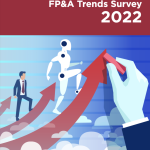The top 7 trends shaping FP&A today can be grouped into 3 key building blocks: Process...

Despite the world’s love affair with technology over the past two years – for the most part, it allowed us to continue working and, for many of us, grow our businesses – could the tide be turning in a wave of short-term thinking and knee-jerk reactions?
Could it be that the surreal and immediate challenges our world faces today are smothering the positivity that is so essential to growth?
According to FP&A Trends Survey 2022, even though the technology is a key enabler of financial planning and analysis (FP&A) activities, there are two major problems in today’s challenging climate for business:
- 36% of FP&A practitioners surveyed said that it was difficult to justify the ROI on FP&A technology against shorter-term sales and marketing activities. This was the number one obstacle they identified in management today.
- Many respondents reported contending with the view that FP&A was not considered a strategic investment area within their company (27%).
How can this possibly be the case when especially cloud-based technology has been considered the saving grace of doing business during the pandemic? Early adopters reaped the rewards by continuing a seamless operation throughout the unimaginable change. Technology allowed businesses to pivot and serve the changing needs of a market that suddenly had to stay home. Hot on the heels of the early adopters were those companies who finally had the incentive they needed to implement the technology they’d been mulling over. And yet, now, it seems a significant proportion of FP&A practitioners are being blocked from implementing the technology that would help guide their managers as they navigate the undoubtedly bumpy road we are on.
The Challenge of Doing Business in Surreal Times
I don’t need to spell out how challenging doing business is today, as we are all living through it. It feels like every day there is a new hit of overlapping impacts, making it more difficult to rebuild our businesses. In surreal times though, it seems to make sense to turn to those masters of surrealist humour, Monty Python, who suggested that we should “always look on the bright side of life”. You might be rolling your eyes right now, wondering both how that is possible today and what any of this has to do with FP&A. Let’s see.
Yes, it might seem contrived and blinkered to present a rose-coloured picture of the world right now, but neither is it helpful to fixate on the fact that times are tough (and basically talk ourselves into a recession). Instead, I think FP&A leaders should be encouraging their management teams to take a leaf out of the Python playbook and actively seek out and communicate good news and progress in a world plagued by despondency.
You Will Find the Good News if You Look
Opportunities and reasons to be optimistic certainly do exist. We’ve seen this happen before, after all. After the 2008 global financial crisis, research from McKinsey showed that companies that moved quickly into a positive, proactive growth mode emerged from the downturn stronger and continued on this trajectory for a decade. On the other hand, companies that got stuck in pessimistic inertia saw the opposite effect. The research saw the same trend happening during the pandemic. Between December 2018 and May 2020, the top 20% of companies analysed grew their profit by $335 billion. The companies in the bottom fifth, meanwhile, lost $303 billion. And this gap was widening to produce a K-shaped recovery: the winners streak ahead, forming the upward arm of the K, and the losers increasingly decline along the downward arm of the K.

Figure 1: Source: McKinsey & Company Research
Avoid Pessimistic Inertia
There are examples of this all around us, big and small. It is mind-boggling that, more than two years of the pandemic later, there are still retailers that have no, or only very basic, mostly manual, e-commerce offerings. Even with access to easy-to-deploy online shopping cart technology and payment gateways, these companies presumably decided it was better to maintain a highly defensive posture and not spend the time and money needed to shift to e-commerce. Unfortunately, if these companies are holding out for every e-commerce shopper to return to bricks and mortar stores, they will continue missing out. Of course, some, even many, shoppers will return to traditional shopping, but they are unlikely to abandon e-commerce altogether and are now comfortable looking further afield for what they want to buy.
The other obvious example of pessimistic inertia is the air travel industry, which staggeringly appears to have been caught on the back foot by the absolutely predictable demand for travel as soon as health restrictions were lifted. Most recently, in the height of the summer holidays, Heathrow Airport capped daily passengers to 100,000 (less than half of its 2018 daily average) and asked airlines to stop selling tickets until September! Multiple factors are at play here, but my general point remains: if you don’t look for opportunities, they will pass you by. (Just like your boarding time when you are still trying to get through airport security after a four-hour queue.)
Stay Focused and Acknowledge the Wins
What does this mean practically for FP&A practitioners? My suggestion is to keep focusing on what your organisation does well and celebrate the victories (even small ones) that move you forward. Don’t forget your people. Balance acknowledging that times are challenging with celebrating the personal wins of your team. Whether or not you prefer working remotely to being back in the office, the reality is that more than two years of working from home has weakened the social ties that form the foundation of morale and team spirit.
Optimism Snowballs
As this optimism starts to snowball, it will lead to bigger wins, strengthened morale, and more cohesion and alignment between the business and your people. Critically, to do this, you need to take a long-term view. Reactionary, short-term thinking might be tempting, but it can only deliver short-term wins and can block long-term progress. The results of the FP&A Trends Survey 2022 I mentioned previously are a case in point.
Be Smart About Long-Term Strategy
Be smart about how you go about looking for opportunities. Don’t fill up on the metaphorical canapés, as tasty as they might look after a long pandemic. You could end up full and have no space for the main courses when they do arrive, which they will. The real opportunities that take your business to the next level of growth are the main courses in this metaphor. Don’t sacrifice long-term strategy on the altar of short-term opportunism.
What this means from an FP&A point of view is that it is vital to enable yourself and your management team to take the long view. Which, in turn, means taking the long view on FP&A technology investment and processes. Without:
- agile and strategic planning capabilities
- on-demand to the point of near real-time forecasting
- rapidly accelerated budget cycles and data-driven decision-making abilities
your management team is at risk of staying out in the reception area, filling up on canapés, and completely missing out on the main event.
Your checklist for success:
1. Enable your management team to take the long view.
2. Invest in FP&A technology and processes to achieve this.
3. Prioritise capabilities that enable:
- On-demand forecasting
- Accelerated budget cycles
- Data-driven decision-making.
Subscribe to
FP&A Trends Digest

We will regularly update you on the latest trends and developments in FP&A. Take the opportunity to have articles written by finance thought leaders delivered directly to your inbox; watch compelling webinars; connect with like-minded professionals; and become a part of our global community.





